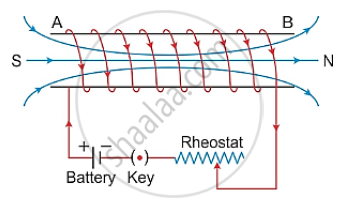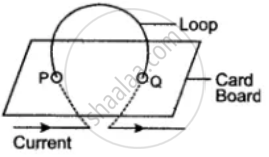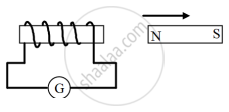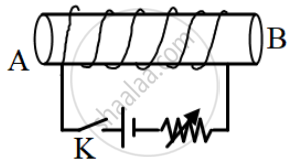Advertisements
Advertisements
Question
Draw a diagram to represent the magnetic field lines along the axis of a current carrying solenoid. Mark arrows to show the direction of current in the solenoid and the direction of magnetic field lines.
Solution

Along the axis of a current-carrying solenoid, the lines of magnetic fields are nearly parallel to one another.
APPEARS IN
RELATED QUESTIONS
State the direction in which current-carrying freely suspended solenoid rests
Why does a current carrying freely suspended solenoid rest along a particular direction? State the direction in which it rests.
Derive the expression for the heat produced due to a current ‘I’ flowing for a time interval ‘t’ through a resistor ‘R’ having a potential difference ‘V’ across its ends. With which name is the relation known? How much heat will an instrument of 12W produce in one minute if it is connected to a battery of 12V?
The diagram shows a current-carrying coil passing through a cardboard sheet. Draw three magnetic lines of force on the board.

State two factors on which magnitude of magnetic field at the centre depends.
The magnetic field lines outside a bar magnet:
The diagram below shows a magnet moved near a coil along its axis. Which of the diagram shows correct flow of current during this motion?

Under what conditions permanent electromagnet is obtained if a current carrying solenoid is used? Support your answer with the help of a labelled circuit diagram.
The diagram below shows an insulated copper wire wound around a hollow cardboard cylindrical tube. Answer the questions that follow:

- What are the magnetic poles at A and B when the key K is closed?
- State two ways to increase the strength of the magnetic field in this coil without changing the coil.
- If we place a soft iron bar at the centre of the hollow cardboard and replace the DC source with an AC source then will it attract small iron pins toward itself when the current is flowing through the coil?
Ansari Sir was demonstrating an experiment in his class with the setup as shown in the figure below.

A magnet is attached to a spring. The magnet can go in and out of the stationary coil. He lifted the Magnet and released it to make it oscillate through the coil.
Based on your understanding of the phenomenon, answer the following question.
Is there any difference in the observations in the galvanometer when the Magnet swings in and then out of the stationary coil? Justify your answer.
Draw a neat diagram of a solenoid and name its various components.
